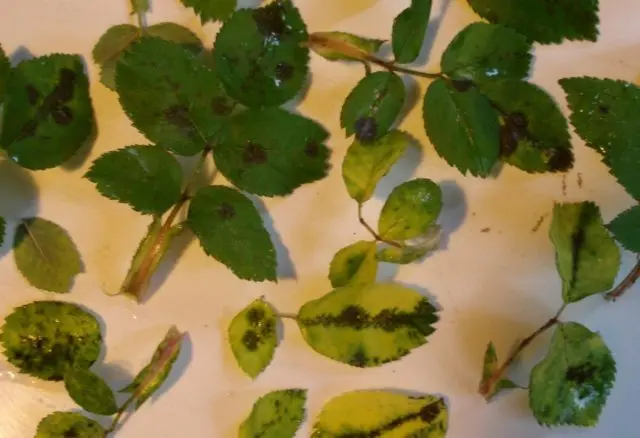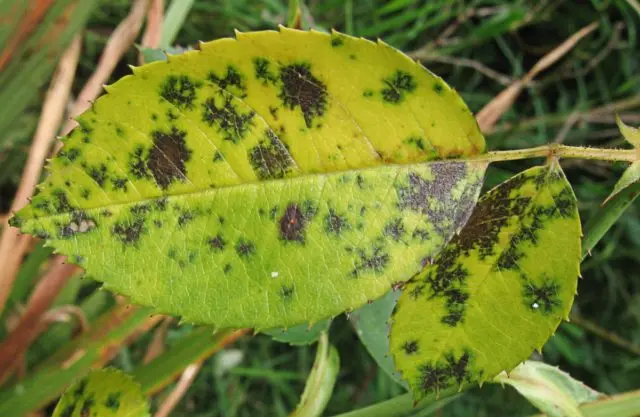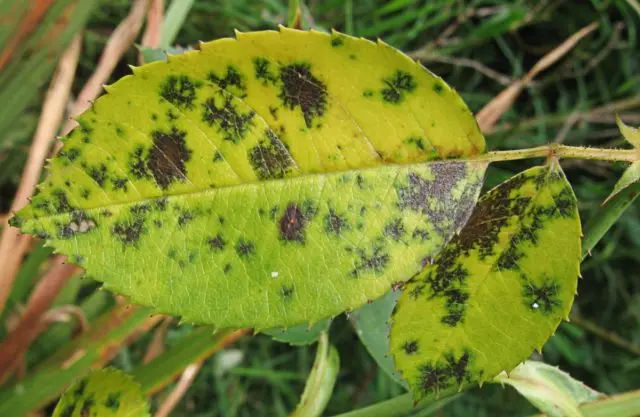Contents
Black spots on the leaves of a rose, like other lesions, cause weakening and help reduce the budding of the plant. If timely measures are not taken to eliminate the disease, the flower may die. It can be very problematic to overcome spotting, it often happens that it spreads to all bushes. Experienced gardeners say that it is much more effective and easier not to treat already infected roses, but to prevent this disease every year.
What does black spot look like and why is it dangerous?
Brown spot on rose bushes is provoked by the fungus Marssonina rosae, which is transmitted during rain or through dew drops, and has a detrimental effect on the culture.
The disease does not appear immediately, rose leaves begin to become covered with black spots 30 days after the development of the fungus. The only exception to the rule is humid, warm weather. At temperatures around 30 degrees, spotting can become noticeable already on the tenth day. But usually it manifests itself in full closer to July.
The first symptoms appear in the lower part of the plant and gradually spread to the top of the bush. Shoots and leaves are covered with dark brown spots with a yellow border. Over time, other symptoms appear:
- spots begin to increase, become black in color;
- the leaves turn yellow and curl, a little later they begin to crumble;
- shoots grow slowly or even stop in development;
- buds become inconspicuous in appearance or completely cease to form on the bushes.

Black spot is difficult to treat and can completely destroy the plant.
Why did black spots appear on the leaves of a rose and they fall off
In order for the treatment of the disease to give a positive result, it is important to correctly determine the reason why black spots appeared on the roses and they shed their leaves. There are several reasons that contribute to the defeat of the bushes:
- Wet and warm weather. It leads to the activation of fungal spores, as a result of which the leaves of roses begin to become covered with brown spots and fall off.
- Inappropriate landing site. A thickened area or lowland contributes to the slow evaporation of moisture, the reproduction and spread of spotting.
- Improper care. Untimely detection of provoking factors can also be the cause of the onset of the disease.
- Using too little or too much fertilizer. Lack or excess of nutrients leads to the development of the disease.
What to do and how to treat black spots on rose leaves
Timely and properly selected treatment of black spot on roses (see the photo of the lesion below) will help get rid of the disease. There are several ways to deal with the disease, but the first thing to do is cut and burn all diseased leaves. If this procedure is neglected, then in the new season the rose will get sick again.
In addition to the destruction of diseased plant elements, gardeners often resort to the use of various means, which are also considered very effective in the fight against black spot. Preparations can be both chemical and biological in nature, some use folk methods.

The foliage of a rose with black spots must be cut off and burned.
Chemicals
If the leaves of the rose turn yellow, become covered with black spots, then they should be treated with chemicals that contain mancozeb and zinc. The most effective among them are:
- Oksihom (Oksihom).
- Profit M (Profit M).
- Cloroxed copper (Cloroxed cuprum).
- Ridomil gold (Ridomil gold).
- Strobes.
Treatment should be carried out every 14 days, constantly changing the drug. This is done so that the fungus does not develop a strong immunity to it.

Treatment of the disease should be carried out until the dark spots stop growing and spreading.
Biological agents
If yellow leaves with black spots are found in a rose, not only chemical, but also biological means can be used to eliminate the problem. As a cure for black spot, Fitosporin-M (Fitosporin-M) with the addition of Zircon or Siliplant has proven itself well. Before processing, all diseased specimens should be destroyed, then the soil should be fed with copper-containing compounds and the bushes should be sprayed with a solution. The procedure should be carried out every 5 days, preferably at least four times. In the intervals between treatments with Fitosporin, the earth around the plants should also be shed.
Folk methods of struggle
You can also deal with dark spots on rose leaves with the help of improvised means. A good folk method against infection is considered to be spraying seedlings with a solution of iodine. In this case, you should use the product carefully so that it does not fall on the ground. Prepare the drug by mixing 1,5 ml of iodine and half a liter of water.
Another folk antifungal remedy is a decoction of onion peel. They can both spray and water the diseased plant. To prepare the medicine, take the husks of two onions and boil it in 500 ml of water.
Cow dung is no less effective against spotting. The mullein is diluted in a ratio of 1 to 20 and the culture is watered with the resulting infusion.
Many gardeners note a good result after using infusions of dandelions, nettles or horsetails.

Traditional methods of dealing with black spot are less effective and are more suitable as prophylactic agents.
How to treat roses from black spot in spring
To avoid the appearance of black spots on the leaves of roses, they should be sprayed in the spring, before bud break. The most common and proven means for primary processing, many gardeners consider copper sulfate (copper sulphate). It is a very powerful fungicide and can only be used once per season. It is diluted in a proportion of 50 g per 1000 ml.
Toward the end of spring, in May, you can additionally spray the roses with the Strobi preparation. This should be done 2-3 times with an interval of 10 days.
How to treat roses from black spot in summer
To help avoid black spotting on roses, a cheap tool “Fitosporin M” is capable. Only the main rule when using it is regularity. The biofungicide will give results if it is used throughout the summer period, every week (especially in August). To increase the effectiveness of Fitosporin, its combination with Gumi paste can.
How to treat roses from black spot in autumn
For a successful wintering, rose bushes are also important to treat with anti-infection agents. You can improve them both by folk methods (onion broth, iodine solution), and by purchased preparations (fungicides).
In autumn, the treatment of roses from black spot is to use “Fitosporin” (if the plant is not sick). Spraying should be carried out with the onset of cold nights, fogs and when dew appears. The frequency of actions is up to 4 times, every 5 days.
At the slightest suspicion of black spot infection, rose leaves should be sprayed with stronger drugs, such as:
- Topaz (topazius).
- Score (skor).
- Bayleton (bayleton).
If the disease covers the entire bush, then it is better to use Hom or Oxych.
Prevention of the onset of the disease
As preventive measures to combat black spot, gardeners use the same means as in the treatment of the disease. The only difference between the procedure is the frequency of use of drugs.
Timely processing of the plant
Spraying must be carried out even before the appearance of black spots on the leaves and on the rose bush, at the time of the onset of warm weather, after the snow has melted. At this time, the fungi do not have time to get stronger and spread. For prevention, fungicides, biofungicides and compositions with copper are usually used:
- Glyocladin or mycosan-I (100 ml per 10 liters of water).
- Copper sulphate.
- Byleton.

The first spraying of roses from black spot should be carried out in early spring.
Planting varieties resistant to the disease
There are no varieties that are 100% immune to rose disease – black spot. But as practice shows, species with glossy leaves are considered the most resistant to damage:
- Grand Amore (Grande Amore).
- Quadra (Quadra).
- Leonardo da Vinci (Leonardo de Vinci).
- Resonance.
- Nostalgie.
- Baroness (Baronesse).
Climbing varieties, as well as tea and polyanthus, are more prone to black spot infection. It is worth refraining from planting such roses if the growing conditions favor the onset of the disease.
Recommendations
To prevent brown spots on rose leaves, it is advisable to follow these recommendations:
- Constantly change drugs. Both the treatment of roses and the measures to prevent black spot should be carried out with different substances. The fungus is well able to adapt to life and can develop immunity to fungicides.
- Take into account the harmfulness of the composition. When purchasing a drug, you should pay attention to its hazard class and strictly follow the recommendations for preparing solutions.
- Burn the affected leaves. The fungus is completely destroyed only after exposure to fire, no other methods work on it.
- Carry out prevention. Every spring, you should spray the leaves and rose bushes well with antifungal drugs, monitor the evaporation of moisture from the ground, and observe the interval between plants when planting.
- Plant only healthy seedlings. You need to buy cuttings of roses strong and uninfected, preferably in specialized stores. Before planting new bushes, it is better to try to quarantine them for 1-2 months.
Conclusion
Black spots on rose leaves can not always provoke the death of the plant. To avoid sad consequences, it is important to diagnose the disease in time and take urgent measures to eliminate it. And it is better not to neglect preventive measures, regularly provide the bush with proper care and not allow the development of black spot at all. If infection occurs, treatment will take a long time.









